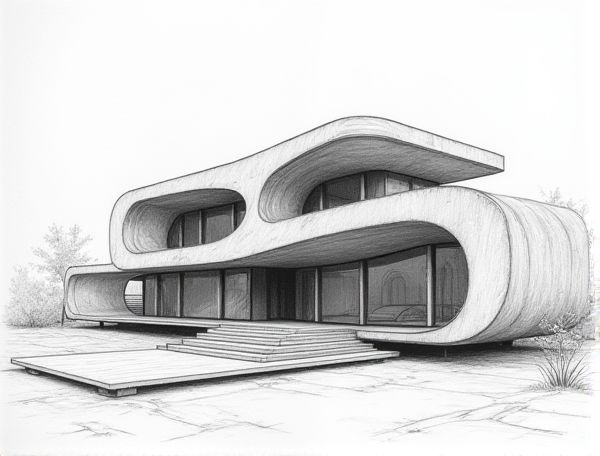
Photo illustration: Futuristic home design with kinetic facade elements
Kinetic facade elements transform your home into a dynamic architectural masterpiece by adapting to environmental conditions and enhancing energy efficiency. Discover how these innovative designs revolutionize modern living and elevate aesthetic appeal by reading more in the article.
Introduction to Futuristic Home Design
Futuristic home design integrates innovative technology, sustainable materials, and smart automation to create living spaces that adapt to your lifestyle and environmental needs. This modern approach emphasizes energy efficiency, seamless connectivity, and minimalist aesthetics to enhance comfort and functionality.
The Rise of Kinetic Facade Elements
Kinetic facade elements enhance your home's exterior by integrating dynamic, movable components that adapt to changing environmental conditions, improving energy efficiency and aesthetic appeal. These innovative systems optimize natural light, ventilation, and thermal regulation, transforming static architecture into interactive, sustainable living spaces.
Benefits of Dynamic Architectural Exteriors
Dynamic architectural exteriors enhance energy efficiency by adapting to changing weather conditions, reducing heating and cooling costs significantly. These facades improve natural lighting and ventilation, creating healthier indoor environments while minimizing dependence on artificial systems. Integrating responsive materials and smart technologies increases a building's aesthetic appeal and market value, promoting sustainable living and long-term investment benefits.
Smart Materials for Kinetic Facades
Smart materials for kinetic facades, such as shape-memory alloys and electrochromic glass, enable dynamic responses to environmental changes by adjusting transparency, shading, and ventilation. These innovative materials improve energy efficiency and occupant comfort while creating visually striking architectural elements.
Energy Efficiency in Futuristic Homes
Futuristic homes utilize advanced insulation materials, solar panels, and smart energy management systems to minimize energy consumption and maximize efficiency. Integrating passive design elements such as strategic window placement and thermal mass further reduces reliance on heating and cooling systems, promoting sustainable living.
Integrating Technology with Home Design
Smart home technology transforms modern interiors by seamlessly incorporating voice-activated assistants, automated lighting, and climate control systems to enhance convenience and energy efficiency. Integrating IoT devices enables real-time monitoring and personalized adjustments, improving security and comfort. Advanced materials and embedded sensors facilitate adaptive environments that respond dynamically to residents' needs and preferences.
Innovative Examples of Kinetic Facades
Kinetic facades integrate dynamic elements such as rotating louvers and adjustable panels that respond to environmental conditions, enhancing energy efficiency and aesthetic appeal in modern home design. Notable examples include the Al Bahar Towers in Abu Dhabi, featuring a responsive mashrabiya system that reduces solar gain by up to 50%, and the Media-TIC Building in Barcelona, which employs pneumatic cushions that expand and contract for natural ventilation.
Customization and Personalization in Modern Homes
Customization and personalization in modern homes enhance livability by reflecting individual tastes and functional needs through tailored interior layouts, unique finishes, and smart technology integration. Advanced design tools enable homeowners to visualize and modify spaces, incorporating features such as adjustable lighting, modular furniture, and personalized storage solutions. These elements increase comfort and efficiency, making each home distinctly suited to the occupant's lifestyle and preferences.
Sustainable Solutions in Futuristic Architecture
Sustainable solutions in futuristic architecture prioritize energy-efficient materials, renewable energy integration, and smart home technologies to minimize environmental impact. Your home design can incorporate green roofs, solar panels, and advanced insulation to promote eco-friendly living. These innovations reduce carbon footprints while enhancing comfort and long-term value.
Future Trends in Home Design and Facade Engineering
Smart home integration and sustainable materials are revolutionizing future home design, emphasizing energy efficiency and environmental impact reduction. Innovative facade engineering incorporates dynamic shading systems and advanced insulation technologies to enhance thermal comfort and reduce energy consumption. Adaptive facades with responsive materials leverage IoT connectivity, creating personalized living environments while maintaining aesthetic appeal and structural performance.
 homedesy.com
homedesy.com